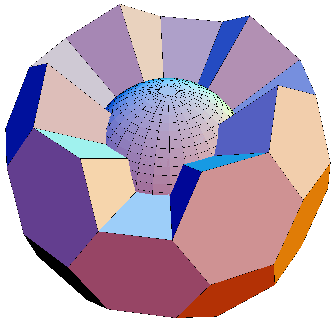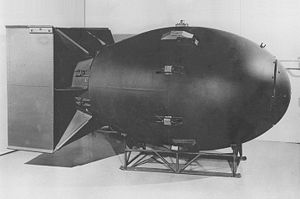Time Travel Research Center © 2005 Cetin BAL - GSM:+90 05366063183 - Turkey/Denizli
Principles of atomic bombs

To explode, the bomb must first be imploded: compress a subcritical spherical fissionable mass (a ball of normal density uranium and other metals) with specially designed explosives. Implosion is the detonation of explosives on the outer surface, instead of the inner surface, which causes the detonation/shock wave to move inward. The engineers working on the bomb had to carefully design a smooth, symmetrical implosion setup so that the shock waves would reach each part of the core at the same time, and that was a very difficult task. Once the shock wave is transmitted to the fissionable core it compresses the core and raises the density to the point of superciticality. Which then leads to a great explosion, which in the case of "Fat Man" is equivalent to 10,000 tons of TNT. Essentially what is happening here is that the fissionable mass is crushed to a great density, and once the mass has reached that supercritical density it goes boom!
There are four main problems that must be taken care of for an atomic bomb
to explode. They are all related with creating a fission chain reaction:
The fissionable material must be kept in a subcritical state before
detonation.
The fissionable material must be brought into a supercritical state while
keeping it free of neutrons. Otherwise most of the fissionable mass would be
used up and it would not generate a large explosion (if any). The neutrons
must be added to the critical mass when it is at maximum supercriticality,
meaning at the most "explosive" point. This can be compared to releasing a
rubber-band when it is fully stretched so it will travel with the most speed.
The fissionable mass must be kept together until a large amount of it has
gone through fission, making it efficient. If the fissionable mass does not
stay together, the fission reaction would immediately be stopped. When the
atomic nuclei in the center of an atomic bomb, which is composed of fissile
materials, are split, an enormous amount of energy is released as
dangerously high levels of heat and radiation. Atomic bombs use this energy
as a weapon for killing.
Other explanation: When a single neutron strikes the nucleus of a fissile
material such as uranium 235 (or plutonium 239), two or three more neutrons
are released. When those neutrons are ejected, enormous energy is released.
The flying neutrons then hit other nuclei of the uranium and cause them to
split in a similar manner, releasing more energy and neutrons. When this
fission spreads, a huge amount of energy is generated instantaneously.
Estimated damages of atomic bombs:
Atomic: (-800 m): Deadly
(-1000 m): Deadly for 50% of all persons
(-2000 m): Shock- and Heatwawe, Neutrons- and Gammaemission
(-2200 m): Destruction of buildings
(-3000 m): Heavy fires
Neutronic: (-200 m): Destruction of buildings
(-800 m): Deadly within 1-2 days
(-1000 m): Deadly within 4-6 days
(-1200 m): Mostly deadly within a few weeks
(-1400 m): Deadly for 50% of all persons
(-3000 m): Neutronic emission
This is a model of a basic Teller-Ulam atomic bomb.
The B28 Type Thermonuclear Bomb
This is a more detailed illustration of the Teller-Ulam configuration as used in the B28 bomb. This example was picked because at one time it represented the backbone of US nuclear weaponry. Also, for what ever the reason, more information seems to be available on this type than most other modern nuclear weapons.
Nuclear Weapon Diagrams
The Teller-Ulam Configuration
Thermal radiation in the form of soft X-rays are released by the fission primary (trigger). The photon gas fills the bomb casing, and produces tremendous pressure that implodes the secondary stage to very high densities. When the implosion shock reaches the center of the secondary, the fission spark plug is compressed. The energy released by the spark plug ignites the fusion reaction, leading to the main energy release in the weapon.
Fusion Boosted Fission Weapon

In this levitated pit design, the thin outer shell of plutonium is driven
inward by the explosive charge at velocities of several kilometers per
second. The impact of this shell on the center sphere of plutonium creates
two very high pressure shock waves, one travelling in toward the center and
one travelling out through the shell. These shocks, with pressures of
several megabars (several million atmospheres) compress the plutonium to
densities of 2.5-4 times normal. The collapse of the central sphere also
compresses the fusion fuel in the center.
When the fission reaction has released enough energy to raise the
temperature in the core to several million degrees K (a few hundred tonnes
of TNT equivalent), a fusion reaction is ignited in the fuel. The deuterium
+ tritium fusion reaction:
D + T -> He-4 + n + 17.6 MeV
produces large amounts of extremely high energy neutrons (14.1 MeV). When
one of these neutrons collides with a plutonium nucleus, it fissions and
releases an additional 4.5 neutrons on average (compared to about 2.9 for
fission induced by lower energy fission neutrons). Since each fusion neutron
directly generates 180 MeV through fission, and another 810 MeV as a result
of the second generation neutrons, the energy released by fusion driven
fission greatly exceeds that produced by the fusion reaction itself.
Schematic of an Implosion Device

In the center is the 'pit' with the neutron source (fission initiator)
which usually consists of tritium gas.
This is also the primary device in a fission-fusion-fission thermonuclear
device.
Fission-Free Neutron Bomb
From _Weapons of Tomorrow_ by Brian Beckett:
" In a fission-free Neutron bomb an efficient driver would generate enough
fusion energy
to cause the explosive shock wave to compress the core to hyper-densities of
10,000 times the
norm. The liner, a heavy metal of variable density would profile the shock
wave for maximum
compression.
Because of size considerations, yields would probably be limited to a
kiloton or less and,
in such things as artillery shells, the device would be a cylinder rather
than a sphere. This would
be less efficient but, with high compression, the weapon would still be
highly effective.
The details illustrate the idea for an enhanced radiation neutron device.
The core might
release around 900 tons of TNT equivalent with up to another 100 tons coming
from the
surrounding shell.
An example of a suitable liner might be a copper-beryllium alloy and the
driver would be
made of a dense metal such as iridium. "
Comments by Carey Sublette: This is a speculative design for producing
fusion reactions without using fissile material to provide the ignition heat.
The idea is to use the energy concentrating effects of an implosion to
create fusion conditions by compressing and heating fusion fuel at the
center. This design combines the several techniques, explosive driven flying
plates, shock profiling from collisions with shock buffers, and the
convergence effect of thick collapsing shells, and spherical implosion waves.
In principal, a highly symmetric implosion system could produce fusion
conditions in a very small central region. Sonoluminescence - the
observation that small bubbles oscillating in a sound field can be made to
glow brightly in the laboratory, apparently through heating to incandescence
- is an example of how temperatures far in excess of ambient conditions can
be created by spherical wave convergence.
It does not appear, however, that significant releases of fusion energy have
ever actually been produced by such systems, much less been developed into
usable weapons. Given the very low energy density in conventional high
explosives compared to fissile material, such a system (even if feasible) is
certain to be far larger and heavier than fission driven neutron bombs.
Since the principal cost factor in a neutron bomb is the very expensive
tritium used as a fusion fuel, it is doubtful any cost advantage would exist
either.
Bi-Conical Mini-Nuke

From _Weapons of Tomorrow_ by Brian Beckett:
"The bi-conical system is said to be capable of compressing uranium or
plutonium by values of five to seven and reducing critical mass to between
54 and 100 gm. The fission cores of such bombs would have diameters of only
2.68 to 3.38 cm (1.05 to 1.33in) but still be capable of one or two kiloton
yields. Very efficient weapons using fusion enhancing reflectors might
enable reliable yields of up to four or five kilotons (Major reference: S.
Kaliski, Journal of Technical Physics, Warsaw, Vol. 19, 4, 1968)."
Comment by Carey Sublette:
This shock wave amplification system relies on the Mach effect created by
colliding shock waves. Work published by the Soviet researcher Alt'shuler
describes achieving pressures of several megabars using this system (shock
pressures in the same range as conventional implosion systems). The claimed
performance of this system appears physically impossible. The five to seven
fold compression factors claimed take us into the regime of Fermi degenerate
matter, requiring pressures far in excess of those described in the
literature. From fundamental physical principles alone it is obvious that
the energy required to achieve this degree of compression in the masses
mentioned implies very large amounts of high explosives, even if the energy
could be efficiently concentrated and applied to achieve the extreme
pressures needed.
Hiçbir yazı/ resim izinsiz olarak kullanılamaz!! Telif hakları uyarınca bu bir suçtur..! Tüm hakları Çetin BAL' a aittir. Kaynak gösterilmek şartıyla siteden alıntı yapılabilir.
The Time Machine Project © 2005 Cetin BAL - GSM:+90 05366063183 -Turkiye/Denizli
Ana Sayfa /
index /Roket bilimi /![]() E-Mail /CetinBAL/Quantum Teleportation-2
E-Mail /CetinBAL/Quantum Teleportation-2
Time Travel Technology /Ziyaretçi Defteri /UFO Technology/Duyuru


